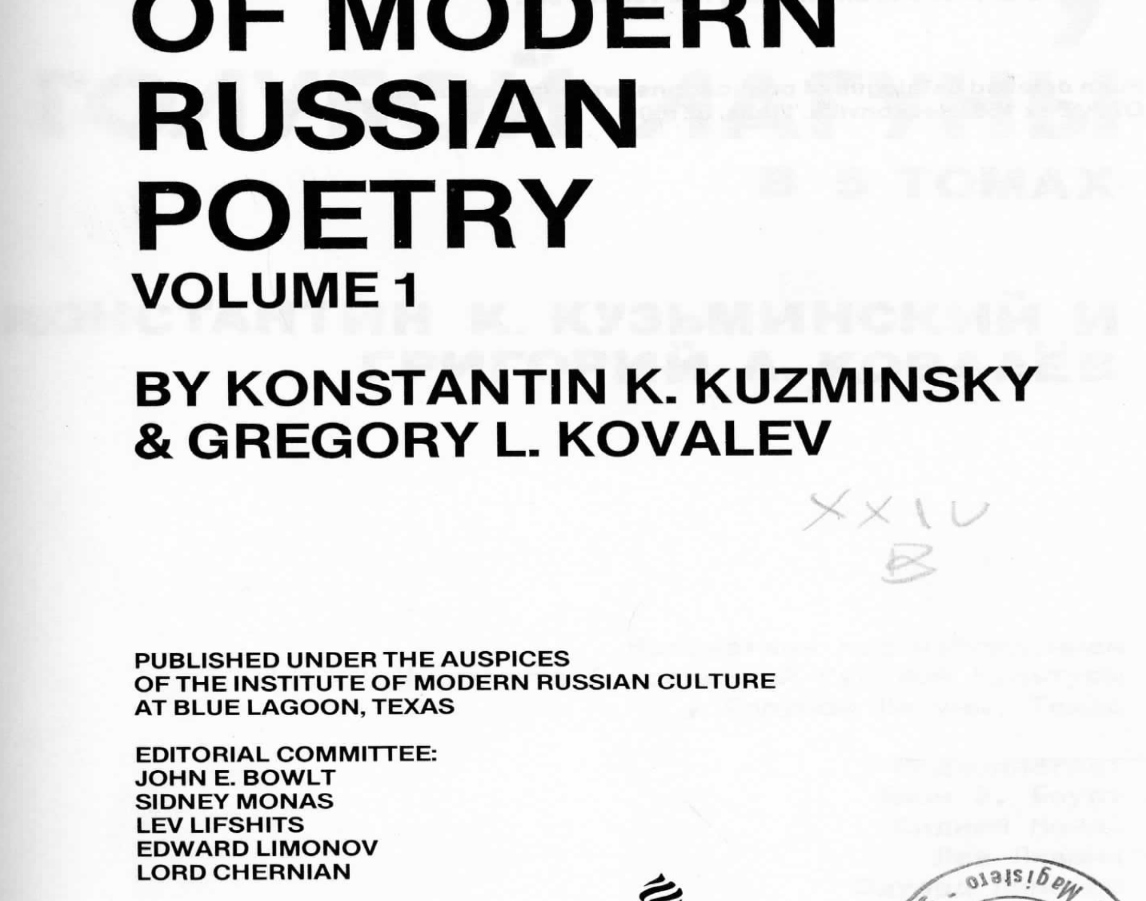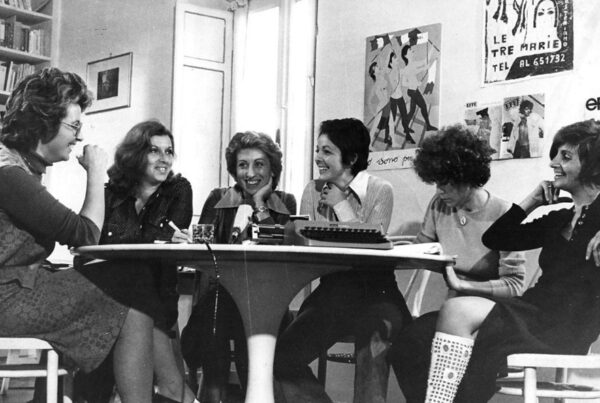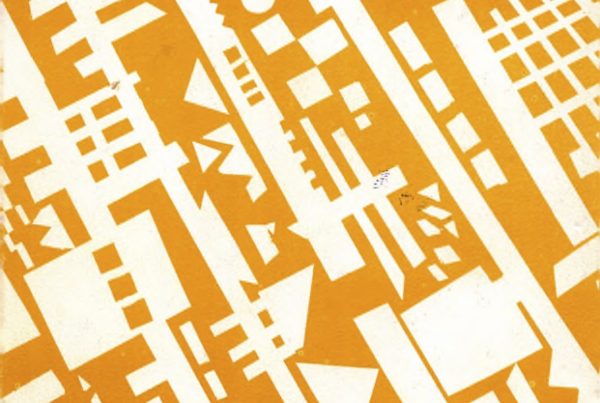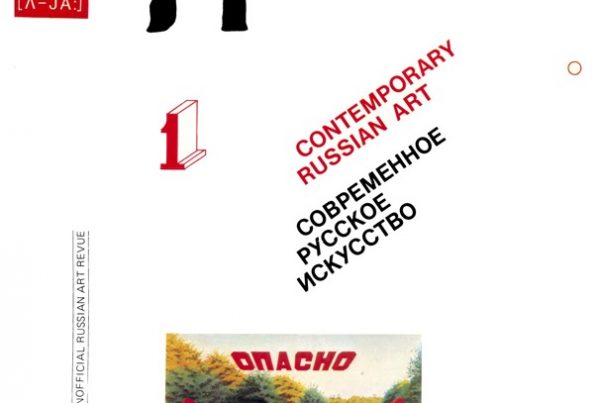
Anthology of the newest Russian poetry At the Blue Lagoon, 1980-1986.
Title:
Antologiia noveishei russkoi poėzii U Goluboi laguny [Anthology of the newest Russian poetry At the Blue Lagoon]
Editors: Konstantin Kuz’minskii (1940-2015) and Grigorii Kovalev (1939-1999)
Years of publication: 1980–1986
Place of publication: Newtonville, Massachusetts
Description:
Printed between 1980 and 1986 with the support of the Institute of Modern Russian Culture at Blue Lagoon (at the time located in Texas, now in Los Angeles), the Antologiia noveishei russkoi poėzii U Goluboi laguny (Anthology of new poetry, At the Blue Lagoon) represents the most important and enduring monument to the samizdat (cf. Caramitti 2010: 24). The work, which aimed to collect unofficial Russian poetry from 1940-1980, consists of nine volumes, each with at least six hundred pages. The creator and editor Konstantin Kuz’minskii included thousands of verses by about one hundred and fifty poets, active mainly in Leningrad and Moscow and replicated hundreds of documents, including letters, memoirs, pictures, paintings, illustrations and collages.
An experimental poet with an overwhelming temper and strength, Kuz’minskii, who was born in Leningrad, was forced to emigrate to the United States in 1975. Before his expatriation, he managed to smuggle a huge number of microfilms and typescripts across the iron curtain (cf. Severiukhin 2003: 24), in support of the alternative culture whose richness and vivacity he had helped to sustain by circulating and editing several anthologies. The crowded non-conformist art exhibitions organised in the tiny studio in Profsoiuzov bul’var where he lived were very popular. Although Kuz’minskii worked alone in the United States to sort the texts for the At the Blue Lagoon collection, the name of Grigorii Kovalev is also mentioned on the title page. Blind since his childhood and known by many as “sightless Grishka”, Kovalev has become a legendary figure. He was defined by Kuz’minskii as the “driving force” of unofficial contemporary poetry (cf. Dolinin 2003: 213). Kovalev was gifted with a prodigious selective memory, which allowed him to memorise “an astronomical quantity” of lines and had an unfailing aesthetic sense, meaning that he selected the best poetry and discarded less meritorious work (cf. Kuz’minskii, O Gr. Kovaleve: web). Kuz’minskii recalled that “all the best [work in the anthology] was gathered by him or thanks to him” (cf. ibid.). The two friends and poets (Kovalev also wrote verses, although, in his own opinion not of a high quality) had already worked as editors together, for example for Antologiia sovetskoi patologii (Anthology of Soviet pathology, 1964), and both played a pivotal role in the publication of the first edition in volume of Brodskii’s poems in 1965.
None of their previous work together, however, can be compared to the publishing of the At the Blue Lagoon anthology. The sequence of nine volumes (listed as five in the subtitle, as volumes 2 to 5 are each subdivided into two volumes) is mostly chronological.
The first three (1, 2a, 2b) embrace the period between the 1940s and the early 1960s, describing the various poetic circles (School of Philologists, School of Geologists, Akhmatova’s Orphans) and individuals (Alik Rivin, Roal’d Mandel’shtam, Genrich Sapgir, Aleksei Khvostenko and Kuz’minskii himself). Volumes 3a, 3b, 4a and 4b include material devoted to the Soviet Union’s peripheral zones (Kharkov, Riga, Tallinn, Kiev etc.), as well as verses by authors active from the mid-1960s (Vladimir Ėrl’, Viktor Krivulin, Sergei Stratanovskii, and Leonid Aronzon, who was born a few years earlier), and descriptions of places and events that influenced the culture of this period (such as Malaia Sadovaia or Café Saigon). The content of the last two volumes (5a, 5b) is varied, including poets such as Viktor Sosnora and Aleksandr Morev as well as verses by Rid Grachev, who was better known for his prose (the inclusion of his poetry highlights his importance in the evolution of all literary genres), anthologies (such as Lepta, which translates as The Offering) and exponents of emerging ideologies such as feminism – special attention is given, for example to Voznesenskaia and her verses.
Despite the aesthetic radicalism of which Kuz’minskii was often accused, the poet was strikingly tolerant towards official Soviet writers (cf. Kulakov 1996: web), dedicating significant space to emblematic figures such as Gleb Gorbovskii, an officially recognised poet (several of his collections had been published) whose lyric poems circulated in samizdat as they would not have been accepted for official publication. Kuz’minskii’s mark is everywhere in the anthology’s pages which are scattered with his critical judgment and personal memories. Although he is often ironic, provocative (cf. Dolinin 2003: 460) or bordering on scandalous (cf. Kulakov 1996: web), his words contribute to providing a more complete idea of the works and their authors who, in many cases, were unknown beyond the narrow circles of the andegraund.
The arbitrariness in the choice of writers included in the anthology (a mark of the very idea of florilegium) has led many to describe At the Blue Lagoon as Kuz’minskii’s personal diary; in volume 3b Kuz’minskii himself writes: “The anthology has long since turned into an autobiography” (Kuz’minskii, Kievskie tipy: web). It would be possible to criticise the collection as lacking in academic rigour (cf. Dolinin 2003: 460) or for seeming distance from literary canons, but both elements reflect the nature of the samizdat, where the difficulties and risks of copying and distributing underground material were very real and the intended readers or as Parisi terms them, the “lettori eccedenti” (surplus readers), accepted unpolished publications in return for freedom and self-determination.
Perhaps also due to its size, few copies of the anthology were printed: only 600 copies for the first volume (reprinted in Moscow in 2006 with a slightly higher print-run) and even less for the following volumes. 250 copies were ordered by the Slavic departments of US universities and 150 were destined for Europe (in Italy, the anthology can be consulted in Florence, Turin, Milan, Venice and Trieste); the remaining copies were given to the authors (cf. Kulakov 1996: web). At the Blue Lagoon turned almost immediately into a bibliographic rarity, so much so that currently a full copy of the collection is present in the Petersburg Library, but not in the catalogue of the much better-stocked Lenin Library in Moscow. All nine volumes are available in full on the website https://kkk-bluelagoon.ru/.
Federico Iocca
[30th June 2021]
Translation by Alice Bucelli
Bibliography
- Caramitti M., Letteratura russa contemporanea: La scrittura come resistenza, Laterza, Bari 2010.
- Davydov D., Antologiia noveishei russkoi poėzii u Goluboi Laguny, “Kriticheskaia massa”, 2 (2006), https://magazines.gorky.media/km/2006/2/antologiyanovejshej-russkoj-poezii-u-goluboj-laguny.html, online (last accessed: 30/06/2021).
- Dolinin V., Ivanov B., Ostanin, B., Severiukhin, D. (eds.), Samizdat Leningrada. Literaturnaia ėntsiklopediia, Novoe Literaturnoe Obozrenie, Moskva 2003.
- Kulakov V., A professorov, polagaiu, nado veshat’, “Novoe Literaturnoe Obozrenie”, 14 (1996), http://www.ruthenia.ru/60s/kritika/kulakov_laguna.htm, online (last accessed: 30/06/2021).
- Kuz’minskii K., Kievskie tipy /prodolženie/, in K. Kuz’minskii, G. Kovalev (eds.), Antologiia noveishei russkoi poėzii u goluboi laguny, Oriental Research Partners, Newtonville 1980-1986 [9 vols.], https://kkk-bluelagoon.ru/tom3b/kiev2.htm, online (last accessed: 30/06/2021).
- Kuz’minskii K., O Gr. Kovaleve /sostavitel’ o so-sostavitele/, in K. Kuz’minskii, G. Kovalev (eds.), Antologiia noveishei russkoi poėzii u goluboi laguny, Oriental Research Partners, Newtonville 1980-1986 [9 vols.], https://kkkbluelagoon.ru/tom3b/kiev2.htm, online (last accessed: 30/06/2021).
- Parisi V., Il lettore eccedente. Edizioni periodiche del samizdat sovietico. 1956-1990, Il Mulino, Bologna 2013.
- Severiukhin, D., Dolinin, V., Preodolen’e nemoty, in V. Dolinin, B. Ivanov, B. Ostanin, D. Severiukhin (eds.), Samizdat Leningrada. Literaturnaia ėntsiklopediia, Novoe Literaturnoe Obozrenie, Moscow 2003: 7-51.
To cite this article:
Federico Iocca, At the Blue Lagoon (K. Kuz’minskii, G. Kovalëv), in Voci libere in URSS. Letteratura, pensiero, arti indipendenti in Unione Sovietica e gli echi in Occidente (1953-1991), a cura di C. Pieralli, M. Sabbatini, Firenze University Press, Firenze 2021-, <vocilibereurss.fupress.net>.
eISBN 978-88-5518-463-2
© 2021 Author(s)
Content license: CC BY 4.0




